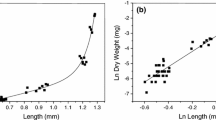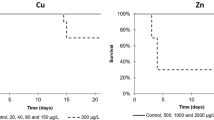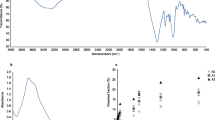Abstract
Changes in life cycle parameters (survival, growth, reproduction) and feeding rate of the tropical cladoceran Ceriodaphnia silvestrii as affected by Cu contaminated algae Pseudokirchneriella subcapitata were investigated. The dietary copper exposure ranged from 3 × 10−15 to 68 × 10−15 g Cu algal cell−1. Low waterborne copper exposure (around 10−10 mol l−1 free Cu2+ ions) was kept in the experiments. The results show an increasing toxic effect on C. silvestrii with copper increase in algal cells; at the highest copper exposure, all life cycle parameters were significantly affected. A concentration of 38 × 10−15 g Cu algal cell−1 reduced egg hatching percentile and the number of neonates produced per female, but did not cause any statistically significant effect on animals survival nor to the number of eggs produced per female. The following sequence of events was observed from the lowest to the highest copper contamination: reproduction, feeding rate, body length and, at last, survival was affected. We conclude that algal cells are an important route of copper exposure and toxicity to cladocerans.


Similar content being viewed by others
References
ABNT (2005) Associação Brasileira de Normas Técnicas. Avaliação da toxicidade crônica utilizando Ceriodaphnia ssp, (Cladocera, Crustacea). NBR13373, julho, 14p, Rio de Janeiro
AFNOR (1980) Association Française de Normalisation. Norme experimentale.T90-304. Essais deseaux Determination de I’inhibition de Scenedesmus subspicatus par une substance
Barata C, Markich SJ, Baird DJ, Soares AMVM (2002) The relative importance of water and food as cadmium sources to Daphnia magna Straus. Aquatic Toxicol 61:143–154
Bossuyt BTA, Janssen C (2005) Copper toxicity to different field-collected cladocerans species: intra and inter species sensitivity. Environ Pollut 136:45–154
Clearwater SJ, Farag AM, Meyer JS (2002) Bioavailability and toxicity of dietborne copper and zinc to fish. Comp Biochem Physiol 132C:269–313
Clément B, Zaid S (2004) A new protocol to measure the effects of toxicants on the daphnids-algae interactions. Chemosphere 55:1429–1438
De Schamphelaere KAC, Janssen CR (2004) Effects of chronic dietary copper exposure on growth and reproduction of Daphnia magna. Environ Toxicol Chem 23:2038–2047
De Schamphelaere KAC, Canli M, Lierde VV, Forrez I, Vanhaecke F, Janssen CR (2004) Reproductive toxicity of dietary zinc to Daphnia magna. Aquatic Toxicol 70:233–244
De Schamphelaere KAC, Stauber JL, Wilde KL, Markich SJ, Brown PL, Franklin NM, Creighton NM, Janssen CR (2005) Toward a biotic ligand model for freshwater green algae: surface-bound and internal copper are better predictors of a toxicity than a free Cu+2 ion activity when pH is varied. Environ Sci Technol 39:2067–2072
De Schamphelaere KAC, Forrez I, Dierckens K, Sorgellos P, Janssen CR (2007) Chronic toxicity of dietary copper to Daphnia magna. Aquatic Toxicol 81:409–418
Fonseca AL, Rocha O (2004) The life-cycle of Ceriodaphnia silvestrii Daday, 1902, a neotropical endemic species (Crustacea, Cladocera, Daphnidae). Acta Limnol Bras 16:319–328
Gauld DT (1951) The grazing rate of planktonic copepods. J Mar Biol Assoc UK 29:695–705
Gulley DD, Boelter AM, Bergman HL (1993) Toxstat version 3.3. Computer Program. Fish Physiology and Toxicology Laboratory, Department of Zoology and Physiology, University of Wyoming Laramie
Hook SE, Fisher NS (2002) Relating the reproductive toxicity of five ingested metals in calanoid copepods with sulfur affinity. Mar Environ Res 53:161–174
Jardim WF, Gimenez SMN, Nery JHS (1986) The use of Cu+2 ion buffers on the calibration of ion selective electrodes. V Simp Eletroq e Eletroanal 226–230
Kaulbach ES, Szymanowski JES, Fun JB (2005) Surface complexation modeling of proton and Cd adsorption onto an algal cell wall. Environ Sci Technol 39:4060–4065
Lee BG, Griscom SB, Lee JS, Choi HJC, Koh CH, Luoma SN, Fisher NS (2000) Influences of dietary uptake and reactive sulfides on metal bioavailability from aquatic sediments. Science 287:282–284
Lombardi AT, Vieira AAH, Sartori LA (2002) Mucilaginous capsule adsorption and intracellular uptake of copper by Kirchneriella aperta (Chlorococcales). J Phycol 39:118–125
Lombardi AT, Hidalgo TMR, Vieira AAH, Sartori AL (2007) Toxicity of ionic copper to the freshwater microalga Scenedesmus acumminitus (Chlorophyceae, Chlorococcales). Phycologia 46:74–78
Lorenzen CJ (1967) Determination of chlorophyll and phaeopigments: spectrophotometric equations. Limnol Oceanogr 12:343–346
Luoma SN (1983) Bioavailability of trace metals to aquatic organisms-A review. Sci Total Environ 28:1–22
Luoma SN, Rainbow PS (2005) Why is metal bioaccumulation so variable? Biodynamics as a unifying concept. Environ Sci Technol 39:1921–1931
Mart L (1979) Prevention of contamination and other accuracy risks in voltammetric trace analysis of natural water. Part I. Preparatory steps, filtration and storage of water samples. Fresenius Z Anal Chem 296:350–357
Nogueira PFM, Melão MGG, Lombardi AT, Vieira AAH (2005) The effects of Anabaena spiroides (Cyanophyceae) exopolysaccharide on copper toxicity to Simocephalus serrulatus (Cladocera, Daphnidae). Freshwater Biol 50:1560–1567
Santos MAPF, Melão MGG, Lombardi AT (2008) The effects of humic substances on copper toxicity to Ceriodaphnia silvestrii Daday (Crustacea, Cladocera). Ecotoxicology to appear (http://dx.doi.org/10.1007/s10646-008-0196-y)
Sofyan A, Shaw JR, Birge WJ (2006) Metal transfer from algae to cladocerans and the relative importance of dietary metal exposure. Environ Toxicol Chem 25:1034–1041
Acknowledgements
We thank the reviewers for valuable comments and suggestions on the manuscript. CNPq (No.154368/2006-7; 472509/2006-3) and FAPESP (No.2007/02073-4) are acknowledged for financial support.
Author information
Authors and Affiliations
Corresponding author
Rights and permissions
About this article
Cite this article
Rodgher, S., Lombardi, A.T., da Graça Gama Melão, M. et al. Change in life cycle parameters and feeding rate of Ceriodaphnia silvestrii Daday (Crustacea, Cladocera) exposure to dietary copper. Ecotoxicology 17, 826–833 (2008). https://doi.org/10.1007/s10646-008-0245-6
Received:
Accepted:
Published:
Issue Date:
DOI: https://doi.org/10.1007/s10646-008-0245-6




